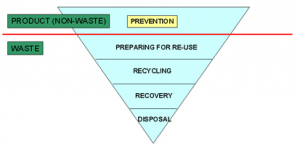Directive about biodegradable waste and waste management hierarchy
“Bio-waste”
means biodegradable garden and park waste, food and kitchen waste from households, offices, restaurants, wholesale, canteens, caterers and retail premises and comparable waste from food processing plants;’ (Directive 2018/851).
Currently the main environmental threat from biowaste and other biodegradable waste such as forestry or agricultural residues, manure, sewage sludge, natural textiles, paper or processed wood, is the production of methane from such waste decomposing in landfills, which accounted for some 3% of total greenhouse gas emissions in the EU-15 in 1995.
The Landfill Directive (1999/31/EC) obliges Member States to reduce the amount of biodegradable municipal waste that they landfill to 35% of 1995 levels by 2016 (for some countries by 2020) which will significantly reduce this problem.
The Landfill Directive does not prescribe specific treatment options for the diverted waste. The most significant benefits of proper bio-waste management – besides avoided emissions of greenhouse gases – would be the production of good quality compost and bio-gas that contribute to enhanced soil quality and resource efficiency, as well as a higher level of energy self-sufficiency. In practice, however, Member States are often inclined not to opt for composting or bio-gas production, and instead choose the seemingly easiest and cheapest option such as incineration or landfilling and disregarding the actual environmental benefits and costs.
Waste management hierarchy
Waste hierarchy (source: https://ec.europa.eu/environment/waste/framework/)
Since 2008 there is a waste hierarchy to be applied as a priority order in waste prevention and management legislation and policy to every Member State (Directive 2008/98/EC). The priority concerning waste management is the prevention of waste and in this step we are in a non-waste step. The steps refer to the best ways on waste management. The best way is to reuse a product, either with another use or another user. If the product cannot be reused, the preferable way is recycling it and if this is not possible the product is used for energy recovery. In any case the product is driven to landfills as the last option when there is no other way to manage it. In our project the basic idea is to exchange waste between companies, so they can be reused.
Sources:
Directive (EU) 2018/851 (amending Directive 2008/98/EC)–> https://eur-lex.europa.eu/legal-content/EN/TXT/?uri=celex:32018L0851
Biodegradable Waste –> https://ec.europa.eu/environment/waste/compost/index.htm
Landfill Directive (1999/31/EC)–> https://eur-lex.europa.eu/legal-content/en/ALL/?uri=CELEX%3A31999L0031
Directive 2008/98/EK –> https://eur-lex.europa.eu/legal-content/EN/TXT/?uri=CELEX%3A32008L0098
Disclaimer
The views expressed in this publication do not necessarily reflect the views of the European Union, the participating countries and the Managing Authority.
